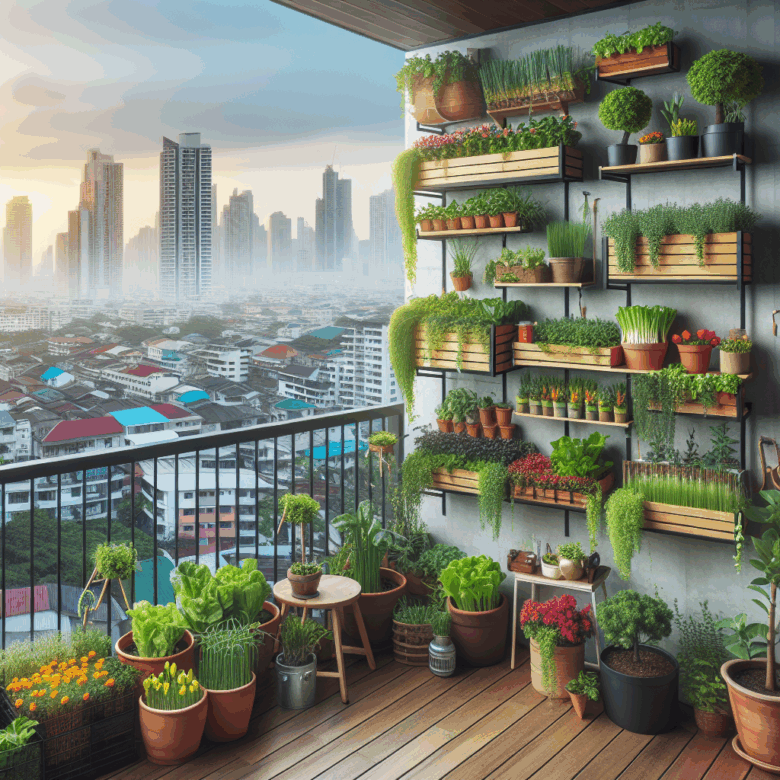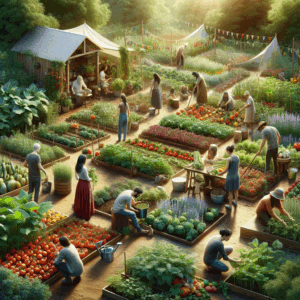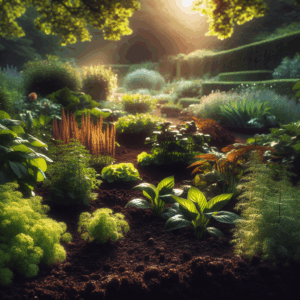Sustainable gardening in small balconies is an innovative approach to urban living, allowing individuals to cultivate plants and vegetables in confined spaces. This article explores effective techniques, container gardening, and creative designs to maximize your balcony’s potential for greenery.
Understanding Sustainable Gardening
Container gardening or pot gardening is a transformative practice that allows individuals to cultivate a variety of plants in confined spaces, making it particularly well-suited for small balconies. This method not only provides an innovative way to utilize limited space but also brings a host of benefits that enhance the gardening experience. One of the most significant advantages of container gardening is its adaptability; with the right selection of containers, gardeners can create visually appealing arrangements that reflect personal style while maximizing the use of vertical and horizontal space.
When choosing containers, it’s essential to consider both size and material. Terracotta pots offer excellent breathability, helping to prevent overwatering, while plastic containers are lightweight and often more versatile in design. Hanging baskets can add a vertical dimension and be perfect for trailing plants, effectively utilizing overhead space. Window boxes are another great option, fitting snugly on windowsills and enhancing the aesthetics of both the garden and the building.
The type of soil used in container gardening is equally crucial. A high-quality potting mix that promotes drainage and retains moisture will support healthy plant growth. Additionally, incorporating organic matter like compost can enrich the soil, offering essential nutrients to the plants.
Selecting the right plants is also vital in optimizing growth within confined spaces. Compact varieties of vegetables, herbs, and decorative plants are ideal. For instance, cherry tomatoes, peppers, and salad greens can thrive in smaller containers, providing fresh produce while enhancing the balcony’s environment.
Ultimately, container gardening encourages a greener lifestyle, enabling urban dwellers to connect with nature, promote biodiversity, and cultivate their own food, all while being environmentally responsible. The integration of efficient practices is not only practical but also an enriching experience, reflecting a commitment to sustainability in urban gardening.
Container Gardening Techniques
Container gardening is an invaluable technique, especially for those working with limited spaces like small balconies. This practice involves growing plants in portable containers rather than in the ground, making it a flexible solution for urban horticulture. The benefits are numerous, particularly in maximizing limited spaces while allowing for an aesthetically pleasing green environment.
When choosing containers, consider both practicality and aesthetic appeal. Popular options include hanging baskets, window boxes, and wall planters. Hanging baskets, ideal for trailing plants, can be suspended to maximize height in space-constrained areas. Window boxes fit perfectly on sills and are suitable for a variety of plants, from flowers to herbs. Wall planters can be mounted on vertical surfaces, providing a canvas for diverse plant types without occupying precious floor space.
Equally important is the selection of soil types, which directly affects plant health. Utilizing high-quality potting mixes that ensure adequate drainage and retain moisture is crucial. Specialized blends for vegetables or herbs may enhance growth, while organic options contribute to sustainable practices. Always ensure that your containers have drainage holes to prevent root rot.
Plant choice also plays a significant role in container gardening. Opt for plants that thrive in confined spaces and offer visual interest. Decorative flowers, aromatic herbs, and even small vegetable varieties like chili peppers or arugula can flourish in containers. Combining plants with differing textures and colors can create a vibrant display while improving biodiversity, aligning with sustainable gardening principles.
Ultimately, container gardening allows for creative expression while fostering an appreciation for nature in our urban environments. It not only beautifies limited spaces but also contributes to a more sustainable future by promoting green practices that can be easily managed and adapted to individual lifestyles.
Vertical Gardening Solutions
Vertical gardening has emerged as an innovative solution for maximizing limited balcony space, transforming what was once an overlooked area into vibrant green oases. This gardening style employs vertical structures, making it possible to cultivate a diverse range of plants without occupying valuable horizontal space. Various systems, such as wall planters and trellises, provide support for climbing plants and allow for creative arrangements that enhance the aesthetic appeal of the balcony.
Wall planters are particularly popular among urban gardeners. These systems often come in modular units that can be mounted directly onto a wall, providing a canvas for a variety of plants, from herbs to flowering species. When selecting wall planters, it’s crucial to consider the type of plants desired, as each plant has specific light and moisture requirements. With proper placement and attention to irrigation, wall planters can turn even the smallest spaces into lush vertical gardens.
Trellises represent another effective vertical gardening solution. These structures can be free-standing or attached to existing walls, allowing climbing plants such as beans, peas, or flowering vines to flourish. By integrating trellises into the balcony design, gardeners can create layers of greenery that not only optimize space but also invite interaction with nature. Additionally, trellises can serve as screens, offering privacy while enhancing the garden’s aesthetic.
Both systems support a wide variety of plant life. From ornamental flowers cascading down wall planters to edible vines climbing trellises, the options are endless. Furthermore, vertical gardening improves air quality and can contribute to the building’s energy efficiency by providing natural cooling. Incorporating these techniques fosters not just gardening success but also promotes environmental well-being, making every balcony a potential urban sanctuary.
Choosing the Right Plants
Choosing the right plants for small balcony gardens is essential for creating a lush green oasis in limited space. When considering herbs, vegetables, and flowering plants, select species that thrive in containers and complement each other. Herbs such as basil, parsley, and chives are ideal for small spaces due to their compact root systems and minimal care requirements. They also require ample sunlight, typically needing around six hours a day to flourish.
Vegetables that adapt well to containers include cherry tomatoes, peppers, and radishes. Cherry tomatoes, for instance, have a delightful yield and can be grown in hanging baskets or pots, ensuring they receive adequate sun exposure while remaining easy to harvest. The key factor in selecting vegetables is to consider their growth habits; fast-growing varieties and those that can produce multiple crops in a season should be prioritized to maximize productivity.
Flowering plants also add vibrancy to balcony gardens. Choose annuals like petunias, geraniums, and marigolds, which bring color and visual appeal. They thrive in the same sunlight conditions as herbs and vegetables and can attract pollinators, enhancing the garden’s ecosystem.
When planning your plant selection, consider factors such as moisture retention and soil quality. A well-draining potting mix enriched with organic matter benefits plant growth by providing necessary nutrients. Regular watering is crucial, as container plants can dry out quickly; however, over-watering can pose risks. Monitor moisture levels closely, particularly during hot weather.
Understanding your balcony’s microclimate can influence plant selection. If your balcony receives morning sun but is shaded in the afternoon, opt for plants that prefer partial sun. The right combination of plants will thrive in this intimate setting, transforming your balcony into a vibrant retreat.
Maintaining Your Balcony Garden
Maintaining a successful balcony garden requires a commitment to routine care, adapting to seasonal changes, and understanding the specific needs of the plants you’ve chosen. **Watering** is one of the most crucial tasks. During warmer months, container plants may require daily watering, while in cooler seasons, this can be reduced significantly. Always water early in the morning or late in the day, avoiding the sunniest hours to prevent evaporation. Check the moisture level of the soil regularly; if the top inch is dry, it’s time to water.
**Fertilization** is another essential component to ensure your plants thrive. Use organic fertilizers such as compost or specialized plant food tailored to your types of plants. During the growing season, typically spring and summer, fertilizing every four to six weeks can enhance growth. In contrast, reduce feeding in fall and winter when plants enter a dormant phase.
**Pest control** is a challenge for balcony gardeners, but several natural methods can help. Companion planting—where compatible plants are grown together—can naturally deter pests. Introduce beneficial insects like ladybugs and lacewings that prey on harmful pests. Regularly inspect your plants for signs of infestation and treat minor issues with neem oil or insecticidal soap for eco-friendly interventions.
**Seasonal plant rotation** is also vital for maintaining a productive garden. In late summer, after harvesting crops like lettuce or radishes, consider transitioning to fall crops such as kale or garlic, depending on your climate. This practice not only increases yield but also improves soil health by allowing different nutrients to replenish.
Creating a sustainable balcony garden involves timely and thoughtful maintenance, ensuring that your limited space thrives as a lively green oasis throughout the year.
Conclusão
In conclusion, sustainable gardening in small balconies opens up a world of possibilities for urban dwellers. By utilizing innovative methods such as container gardening and vertical spaces, anyone can create a lush environment that not only beautifies but contributes to sustainable living in an urban context.



